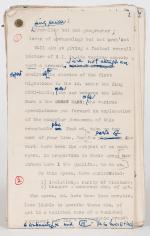[Luke, Easter Island [Manuscript - Pad of Harry Luke - with his personal
Easter Island [Typescript / Manuscript – Proof – Pad of Harry Luke – with his personal note and corrections on the article on Easter Island which he prepared during and after his visit in April and May 1952 for “The Geographical Journal” (published subsequently in Volume CXX, Part 4, 1954)].
[This item is part of the Sir Harry Luke – Archive / Collection]. [London], [1952]. Octavo. 32 pages. Stapled. From the private collection / library of colonial governor, diplomat and historian, Sir Harry Luke.
The printed version of the article includes the following highlights / excerpts (Text of the note-pad is an early stage of the finished article): “Easter Island was a no-man’s land from the time that Spain was compelled to relinquish her South American possession until 1888… for more than two generations at the mercy of the ‘blackbirders,’ those scourges of the Pacific who roamed from island to island, seizing by force defenceless natives to work out their plantations, mines and the like. Easter Island was one of the many islands all but ruined by these depredations.″
“The breach of continuity to which I have referred was brought about by the development of the guano industry on the rocky islands off the Peruvian coast, which began at the end of the 1850s. From 1859, and especially in the organized raid of December 1862, most of Easter Island’s able-bodied men and its leaders, including King Kaimakoi, his son and many of the learned elders (maori), were crimped by Peruvian blackbirding expeditions and transported to those sun-scorched, glary, waterless pieces of rock whose only covering consists of deposits of stinking guano.″
“The fifteen who lived to see their island again introduced the smallpox to a community that had no immunity… most of those who had escaped the clutches of ‘blackbirders’ lost their lives in the consequent epidemic.″
“Adorned with clumps of eucalyptus, Persian lilac, cypress and bamboo, it is a place that leaves a lasting impression and many questions with all visitors past and present. The isolation of Easter Island, its numerous and bizarre works of art, combined with the rarety of its visitors some 50 years ago contributed to a great deal of speculation and attempted explanations of the unknown phenomena.″
“… I am the ‘ex-Governor of the British Colonies in the Pacific’ referred to in Chapter 3 of Thor Heyerdahl’s fascinating book as having been present on 27 April 1947 at the launching of his most famous of rafts… I was therefore anxious… to see how far the works of Easter Island culture support his theory…″
[Recounting his visit to Easter Island in April and May 1952, the widely travelled author presents a lively account of the lesser-known history of slavery and slave-driven industries which nearly devastated the famous volcanic island, including the especially ruinous guano industry raid of 1862. [In 1862, Peruvian slavers made a ruthless raid on Rapa Nui and took about a thousand islanders – including the king – to work the guano deposits on Peru’s Chincha Islands. The hardships and oppressions endured by the Chinese laborers who were employed in digging guano have been descrbed as a system of the worst kind of slavery.]
In contrast, he also discusses the political and economic situation at the time of his visit, including the merino sheep industry, artisans retaining one ancient tradition, and British-led efforts to support the social well-being of the inhabitants which had been terminated for political reasons by the Chilean government in 1953. Following a firsthand description of the moai monolithic human figures carved by the Rapa Nui people, and remarks on the Bird-man cult, Luke concludes by revealing that the Commonwealth was considering establishing an air route from Australia to Chile, including the construction of an air strip on Easter Island. [The most remote airport in the world, Mataveri International Airport, began its service in 1967.] (Source of this description: Voyager Press).
- Keywords: British Colonial Administration · British Colonial History · British Foreign Office · British Foreign Policy · British Western Pacific Material / Sir Harry Luke Collection · Chile · Easter Island · Harry Luke – Pacific (1938 – 1947) · Manuscript · Manuscript / Autograph – Rare · Manuscript Journal · Osterinsel · Osterinseln · Rapa Nui · Sir Harry Luke · Sir Harry Luke – Personal Archive of Books and Correspondence · Sir Harry Luke Collection · South America · Travel & Expedition – Rare · Travel South America – Rare
- Language: English
- Inventory Number: 30203AB
EUR 275.000,--
© 2024 Inanna Rare Books Ltd. | Powered by HESCOM-Software












